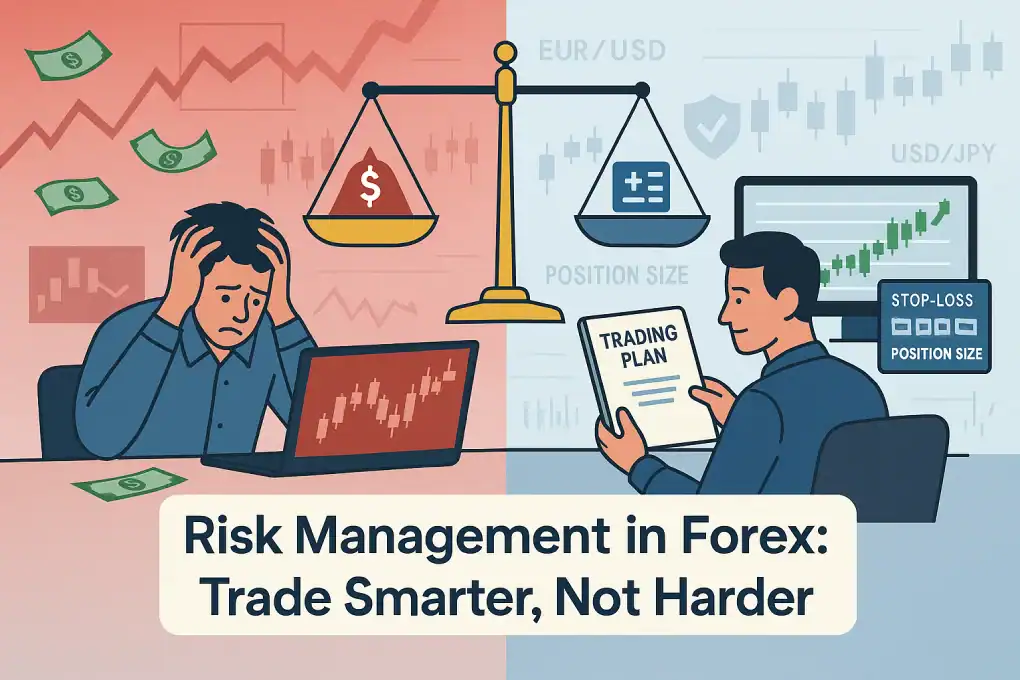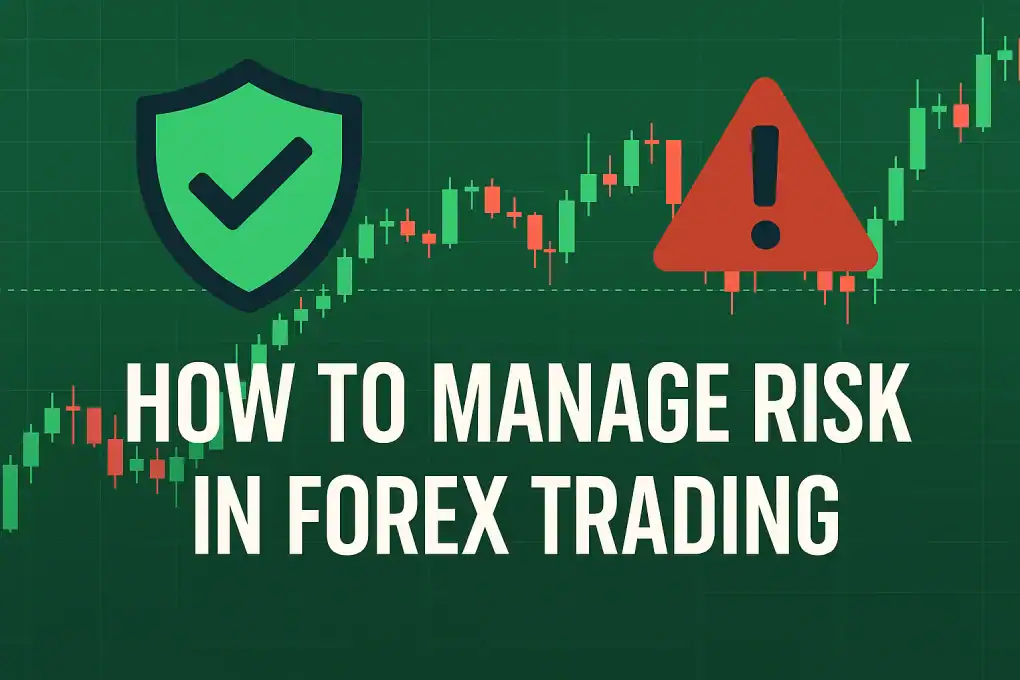Risk control is the base for successful Forex trading. Without risk management, no matter how good your analysis or how great your scheme for how the game will play out, things can go very wrong. Most novice traders concentrate solely on how much they stand to gain, and most never stop to think about exactly how fast they can lose tic for tic. How you learn and implement proper forex risk management determines whether you become a long-term success, or yet another statistic. In this post, you will learn how to manage your risk with logical methods, proven psychological discipline and tools that will move your account in the right direction, growing while keeping losses under wraps.
Understanding Forex Risk
Before managing risk, you must first understand what it means. In Forex trading, risk refers to the potential of losing money due to price fluctuations, leverage misuse, or poor decision-making. Unlike other markets, Forex operates with high volatility, which means prices can change rapidly. Every trade you place carries some degree of uncertainty. Recognizing this and planning accordingly is crucial. When you approach Forex with a clear understanding of risk, you stop gambling and start trading with purpose.
Types of Risk in Forex Trading
Forex traders face several types of risks that can impact their results. Market risk, driven by price volatility, is the most common and occurs when prices move against your position. Liquidity risk happens when it becomes difficult to enter or exit trades at the desired price, often during low-volume hours. Then there’s interest rate risk, which relates to central bank decisions, and geopolitical risk, which includes events like elections or wars. Being aware of each type allows you to adapt your strategy and reduce your vulnerability to market surprises.
Why Risk Management Matters in Forex
Risk management is what separates successful Forex traders from those who fail. It’s not about avoiding losses entirely—because losses will happen—but about controlling their size and impact. A solid risk management strategy ensures that no single trade will ruin your account. It also helps you maintain consistency, reduce emotional stress, and stay in the game longer. By managing your risk, you gain more confidence and reduce the fear that often leads to poor decision-making.
Essential Forex Risk Management Strategies
Applying structured risk management strategies is key to surviving and thriving in Forex trading. These strategies serve as your defense system, protecting your account from large losses. From proper trade sizing to setting smart risk-to-reward ratios, these techniques work best when applied consifstently. Traders who use them develop the discipline needed to handle both winning and losing streaks, all while staying focused on the long-term goal: consistent profitability and capital preservation.
Using a Risk-to-Reward Ratio
The risk-to-reward ratio simply quantifies how much you are willing to risk in an effort to attain a profit. For instance, if you put up 50 pips to earn 100 pips, your ratio is 1:2. This is because even if more trades are lost than won, your wins will counteract losses. Maintaining a positive ratio, such as 1:2 or 1:3, is a sensible approach that keeps you profitable in the long run. It’s what keeps you from making trades without a plan and from making emotional decisions.
Capital Preservation Techniques
Capital preservation means keeping your trading account alive through all market conditions. One of the best ways to do this is to only risk 1% to 2% of your capital per trade. Avoid overtrading, stick to your strategy, and never chase losses. Avoiding large drawdowns gives you more opportunities to recover from losing streaks. The main goal is to survive long enough in the market to let your edge play out. Smart traders think defense first, profits second.
Position Sizing and Stop-Loss Placement
Two of the most powerful tools in risk management are position sizing and stop-loss placement. Position sizing ensures you risk an appropriate amount based on your account size. Stop-losses define where you’ll exit a trade to limit losses. Used together, they help maintain consistency and keep losses small. Mastering these concepts prevents you from risking too much and allows you to stay in control regardless of market volatility.
Calculating Proper Position Size
Position size is determined by how much you’re willing to risk, your account balance, and how far your stop-loss is from entry. For example, if you risk 2% of a $5,000 account with a 50-pip stop, your position size should be calculated to not lose more than $100. Using position sizing calculators makes this process easier. Proper sizing ensures your losses stay manageable and that one bad trade doesn’t cause major damage.
Setting Effective Stop-Loss Orders
A stop-loss is a predefined price at which you exit a losing trade. It’s your last line of defense against large losses. To set an effective stop-loss, base it on recent market structure—such as support and resistance—not random points. A good stop-loss gives your trade room to breathe while protecting your capital. Traders who skip this step often regret it when the market turns against them unexpectedly.
You can get many useful tools for trading from Greg Forex Store in best prices.

Managing Leverage and Avoiding Margin Calls
Leverage can magnify profits, but it also increases risk dramatically. Many traders overleverage, hoping to earn big quickly, only to face margin calls and account blowouts. Smart risk management involves using conservative leverage ratios and understanding how your broker calculates margin. When used carefully, leverage can help; when abused, it can destroy your account.
The Dangers of Overleveraging
Overleveraging means opening trades that are too large for your account. A small price movement in the wrong direction can result in massive losses. For instance, using 100:1 leverage means a 1% market move can wipe out your account. This is why many brokers now limit leverage. To avoid overleveraging, trade smaller positions and focus on consistency over high returns. It’s not about how fast you can grow—it’s about how long you can last.
Avoiding Margin Calls in Forex
A margin call occurs when your account no longer has enough equity to support your open trades. Your broker may automatically close your positions to prevent further losses. To avoid this, use proper risk management, don’t overtrade, and always monitor your free margin. Setting alerts for equity drawdowns can help you stay proactive. Avoiding a margin call should be a top priority for every trader.
Trading Psychology and Emotional Control
Risk in Forex trading isn’t just technical—it’s psychological. Emotional control is often the missing piece in many traders’ plans. Fear and greed are powerful forces that can lead to irrational decisions, like moving stop-losses or revenge trading. A calm and disciplined mindset helps traders make objective choices and avoid sabotaging themselves.
Common Psychological Mistakes
Many traders make emotional mistakes such as doubling down on losing trades, entering without confirmation, or abandoning their strategy after a loss. These actions often stem from fear, ego, or frustration. The key to overcoming them is self-awareness. Recognizing when you’re being emotional allows you to pause, reflect, and return to your plan with a clear head.
Building Discipline in Forex Trading
Discipline is developed through consistent habits and routines. It means sticking to your rules even when things aren’t going your way. Keep a trading journal, review your trades weekly, and learn from both wins and losses. Over time, discipline becomes your greatest advantage, allowing you to stay focused and emotionally balanced in any market condition.
Get best forex trading tools in only 5 Dollars from Greg Forex 5$ Shop.
Creating a Personalized Trading Plan
Every successful trader has a personalized trading plan. This plan includes entry rules, risk parameters, exit strategies, and guidelines for reviewing performance. A trading plan provides structure and prevents you from making impulsive decisions. Without a plan, you’re reacting emotionally to the market rather than following a tested process.
What to Include in a Trading Plan
A solid trading plan outlines your trading strategy, risk limits, acceptable setups, and goals. It should also include your maximum daily loss, position sizing rules, and review schedule. By defining all aspects of your trading ahead of time, you reduce stress and improve consistency. A clear plan is your roadmap to disciplined and sustainable trading.
Reviewing and Updating Your Plan
Markets evolve, and your plan should too. Regularly review your trading results and update your plan based on performance. If your strategy no longer delivers consistent results, test and adjust it. But don’t change it after just a few losses. Use data and long-term results to decide when updates are truly necessary.
How Much Should You Risk Per Trade in Forex?
Risking the right amount per trade is one of the most important parts of Forex risk management. Most professionals recommend risking 1% to 2% of your account per trade. This allows for multiple trades without wiping out your capital. Keeping risk low gives you room to grow and recover from losing streaks.
Risk Percentages and Account Survival
High risk can lead to fast rewards, but it also means fast losses. Risking more than 5% per trade can blow your account in a few bad trades. A trader who risks 1% per trade can survive longer, learn more, and refine their strategy with less pressure. It’s a slow but steady path to real success.
The Math Behind Risk Management
The math is simple but powerful. If you risk 2% per trade and win half of your trades with a 1:2 ratio, your account will grow steadily. But if you risk 10%, you only need a few losses to wipe out your gains. Proper risk math turns average strategies into profitable ones over time.
Daily and Weekly Risk Limits
Setting daily and weekly loss limits keeps your emotions in check and protects your capital. If you lose more than your limit, walk away for the day or week. This break gives your mind time to reset and prevents revenge trading. Consistent traders respect limits and avoid blowing their account due to a few bad trades.
Benefits of Daily Risk Limits
Daily risk limits protect your mental and financial capital. If you lose 3% in one day, it’s best to stop and reassess rather than chase losses. These rules reduce stress, promote discipline, and help you trade with a clear mind. Even professional traders follow daily risk caps to avoid burnout.
Sticking to Weekly Drawdown Caps
Weekly drawdown caps are a safeguard for long-term survival. If you hit a 6% weekly loss, take a break, analyze your performance, and prepare for a fresh start. It’s about controlling damage before it gets worse. Drawdown caps help you maintain control and trade more strategically, not emotionally.

Tools and Resources for Managing Risk
There are plenty of tools and resources available to help traders manage risk effectively. From calculators and alerts to trade journaling apps and backtesting platforms, these tools provide clarity and control. Leveraging them correctly helps you make smarter decisions and improves your trading consistency.
Using Forex Calculators
Forex calculators help you determine position size, pip value, and margin requirements quickly. They eliminate guesswork and ensure you’re trading within your risk limits. These tools are often free and easy to use, making them essential for every trader who wants to stay disciplined and data-driven.
Setting Alerts and Automation
Trading alerts notify you when specific price levels or technical conditions are met, helping you avoid emotional entries. Automation tools like expert advisors (EAs) can also help by executing trades based on pre-set rules. These tools ensure consistency and reduce the impact of emotional decision-making.
Conclusion
The art of good risk management is the key to long-term success in Forex trading. It’s not just about not losing; it’s about managing losses, learning from them, and maintaining consistent performance regardless of what the market keeps throwing at you.
If you wanted to learn more about forex trading visit our Detailed Article A Complete Guide To Forex Trading.
When you know the variety of risks which forces traders to the brink of bankruptcy, and implement things such as proper position sizing, correctly placed stops, and realistic risk limits, you insulate your money and provide yourself the possibility to build your account gradually. Put all of these techniques together with emotional discipline and a good trading plan, and trade smarter, more confidently and less stressed.
In the long-term, trading the Forex market is not about hitting home runs—it’s about staying in the game and letting your small, yet consistent, wins snowball over time.




